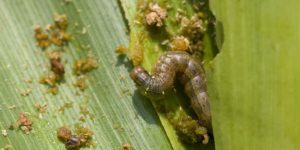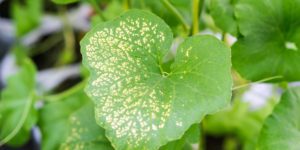Papaya ringspot disease is caused by Papaya ringspot virus – type P (PRSV-P).
It is one of the most destructive diseases of papaya which occurs in nearly every region where papaya is grown.
Papaya trees of all ages are susceptible and generally will show symptoms two to three weeks after inoculation.
HOST PLANTS
The host range of PRV-P is limited to plants in the families Caricaceae (Papaya), Cucurbitaceae (e.g. cucumber, squash), and Chenopodiaceae, where it causes significant infections.
Papaya is however the primary host.
SPREAD
Papaya ringspot disease is spread from plant-to-plant by aphids, which are small sap-sucking insects. There are many species of aphids that are capable of transmitting the virus.
When an aphid feeds on an infected plant, its mouth become contaminated with the virus, within a few seconds and when it moves to the next host plant to feed, the virus is transmitted.
The disease does not survive in soil or dead plant material.
The movement of infected plants can spread the virus over long distances and is the most likely pathway for this disease to spread.
PRV can also be transmitted by mechanical means such as by using the same garden tools on both infected and non-infected trees.
SYMPTOMS
Symptoms due infection may vary in intensity, but dark green, often slightly sunken, rings are diagnostic.
The number of rings on fruits can be variable. These rings however become less distinct as the fruit matures and yellows.
Fruits often show uneven bumps, especially those that develop after the tree is infected.
Other key symptoms are intense and conspicuous yellow mottling / mosaic on leaf lamina, followed by severe blistering and leaf distortion. Vein clearing also occurs especially on young leaves.
Dark green streaks and sometimes rings develop on the leaf stalks and stems.
The leaf canopy becomes smaller as the disease progresses due to the development of smaller leaves and stunting of the plant.
Fruit quality, particularly flavour, is adversely affected.
Fruit yield and brix levels are markedly lower than fruit from healthy plants.
Leaf and fruit symptoms are most intense during the cool season and leaves often develop a shoe-string appearance caused by the extreme reduction of leaf lamina similar to that caused by broad mites.
Trees infected at a very young stage never produce fruit but rarely die because of the disease..
MANAGEMENT STRATEGY
There is no cure for papaya ringspot disease once infection has occurred. However, several methods can be used to prevent, control and/or manage the disease.
These methods include the following;
Chemical method
This is primarily used to control the vectors (aphids) which spread the disease.
The following insecticides are recommended for use against aphids:
- KINGCODE ELITE 50EC 10ml/20l
- PENTAGON 50EC 10ml/20l
- LEXUS 247SC 8ml/20l
- SINOPHATE 750SP 20g/20l
- PRESENTO 200SP 5g/20l
- EMERALD 200SL 10ml/20l
- LOYALTY 700WDG 5g/20l
- EPITOME ELITE 500SP 10g/20l
- DEFENDER 25EC 40ml/20l
Non- chemical methods
- Use of disease-free planting materials
- Infected plants should be selectively removed as soon as symptoms are noticed. They should not be composed.
- Planting resistant/tolerant cultivars
- Maintenance of field hygiene
- Rotations with non-host plants
- Working tools and equipment should be sterilized after and before use.
NB;
- All foliar sprays should be incorporated with INTEGRA 3ml/20l, which is a sticker, spreader and penetrant. It improves the efficacy of the insecticide.
- Spraying crops with OPTIMIZER 10ml/20l helps in boosting their immunity. It is also a super stress manager.
- Timely control of vectors is very critical for effective control of the disease.
[vc_column width=”1/4″][vc_column width=”1/2″]Last Updated: [last-modified][vc_column width=”1/4″]






